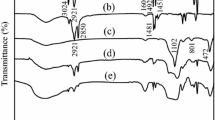Abstract
In chemical mechanical polishing (CMP) process, to obtain efficiently damage-free surfaces, the structural design of abrasive provides a helpful solution. In this work, highly monodisperse polystyrene (PS) nanospheres [Circa (ca.) 70 nm] were synthesized via a modified soap-free emulsion polymerization. The CeO2 nanoparticles (ca. 5 nm) were uniformly coated on the surfaces of the PS cores via an in situ chemical precipitation process. The core–shell structured PS@CeO2 nanocomposites (ca. 90 nm) with a shell thickness of ca. 10 nm were achieved. The samples were further characterized using field emission scanning electron microscopy, transmission electron microscopy, X-ray diffraction and thermo-gravimetric analysis. The CMP performance of the as-prepared PS@CeO2 nanocomposites and conventional CeO2 nanoabrasives for SiO2 film formed on Si wafer was investigated by an atomic force microscope and a 3D non-contact surface profiler. The results showed that the substrate polished with PS@CeO2 nanocomposites exhibited a lower root-mean-square surface roughness (0.15 ± 0.02 nm) and higher material removal rate (189 ± 19 nm/min) than those of conventional CeO2 nanoabrasives (0.25 ± 0.03 nm, 97 ± 16 nm/min). The improved polishing performance might be attributed to the optimization of the physical contact behavior between particles and wafers.







Similar content being viewed by others
References
H. Pirayesh, K. Cadien, Chemical mechanical polishing in the dry lubrication regime: application to conductive polysilicon. J. Mater. Process. Technol. 220, 257–263 (2015)
H. Deng, K. Hosoya, Y. Imanishi, K. Endo, K. Yamamura, Electro-chemical mechanical polishing of single-crystal SiC using CeO2 slurry. Electrochem. Commun. 52, 5–8 (2015)
S. Armini, C.M. Whelan, K. Maex, Engineering polymer core–silica shell size in the composite abrasives for CMP applications. Electrochem. Solid State Lett. 11, H280–H284 (2008)
S. Armini, J. De Messemaeker, C.M. Whelan, M. Moinpour, K. Maex, Composite polymer core-ceria shell abrasive particles during oxide CMP: a defectivity study. J. Electrochem. Soc. 155, H653–H660 (2008)
Y. Chen, Z. Li, N. Miao, Polymethylmethacrylate (PMMA)/CeO2 hybrid particles for enhanced chemical mechanical polishing performance. Tribol. Int. 82, 211–217 (2015)
L. Zhang, H. Wang, Z. Zhang, F. Qin, W. Liu, Z. Song, Preparation of monodisperse polystyrene/silica core–shell nano-composite abrasive with controllable size and its chemical mechanical polishing performance on copper. Appl. Surf. Sci. 258, 1217–1224 (2011)
A. Chen, W. Mu, Y. Chen, Compressive elastic moduli and polishing performance of non-rigid core/shell structured PS/SiO2 composite abrasives evaluated by AFM. Appl. Surf. Sci. 290, 433–439 (2014)
Y. Chen, R. Long, Polishing behavior of PS/CeO2 hybrid microspheres with controlled shell thickness on silicon dioxide CMP. Appl. Surf. Sci. 257, 8679–8685 (2011)
K. Shibuya, D. Nagao, H. Ishii, M. Konno, Advanced soap-free emulsion polymerization for highly pure, micron-sized, monodisperse polymer particles. Polymer 55, 535–539 (2014)
Z. Hu, X. Yang, J. Liu, Y. Yang, L. Wang, Y. Zeng, An investigation of the effect of sodium dodecyl sulfate on quasi-emulsifier-free emulsion polymerization for highly monodisperse polystyrene nanospheres. Eur. Polym. J. 47, 24–30 (2011)
W.P. Wang, C.Y. Pan, Preparation and characterization of polystyrene/graphite composite prepared by cationic grafting polymerization. Polymer 45, 3987–3995 (2004)
N. Sutradhar, A. Sinhamahapatra, S. Pahari, M. Jayachandran, B. Subramanian, H.C. Bajaj, A.B. Panda, Facile low-temperature synthesis of ceria and samarium-doped ceria nanoparticles and catalytic allylic oxidation of cyclohexene. J. Phys. Chem. C 115, 7628–7637 (2011)
I. Yamaguchi, M. Watanabe, T. Shinagawa, M. Chigane, M. Inaba, A. Tasaka, M. Izaki, Preparation of core/shell and hollow nanostructures of cerium oxide by electrodeposition on a polystyrene sphere template. ACS Appl. Mater. Interfaces 1, 1070–1075 (2009)
M.K. Klein, N.R. Saenger, S. Schuetter, P. Pfleiderer, A. Zumbusch, Shape-tunable core-shell microparticles. Langmuir 30, 12457–12464 (2014)
S. Yang, C. Song, T. Qiu, L. Guo, X. Li, Synthesis of polystyrene/polysilsesquioxane core/shell composite particles via emulsion polymerization in the existence of poly(γ-methacryloxypropyl trimethoxysilane) sol. Langmuir 29, 92–101 (2013)
D. Guo, G. Xie, J. Luo, Mechanical properties of nanoparticles: basics and applications. J. Phys. D Appl. Phys. 47, 013001–013025 (2014)
F. Ilie, Models of nanoparticles movement, collision, and friction in chemical mechanical polishing (CMP). J. Nanopart. Res. 14, 752–761 (2012)
S. Armini, I.U. Vakarelski, C.M. Whelan, K. Maex, K. Higashitani, Nanoscale indentation of polymer and composite polymer-silica core-shell submicrometer particles by atomic force microscopy. Langmuir 23, 2007–2014 (2007)
Y. Chen, W.B. Mu, J.X. Lu, Young’s modulus of PS/CeO2 composite with core/shell structure microspheres measured using atomic force microscopy. J. Nanopart. Res. 14, 696–705 (2012)
Y. Chen, C. Qian, N. Miao, Atomic force microscopy indentation to determine mechanical property for polystyrene-silica core-shell hybrid particles with controlled shell thickness. Thin Solid Films 579, 57–63 (2015)
T. Hoshino, Y. Kurata, Y. Terasaki, K. Susa, Mechanism of polishing of SiO2 films by CeO2 particles. J. Non-Cryst. Solids 283, 129–136 (2001)
Acknowledgments
The work was supported financially by the National Natural Science Foundation of China (51205032, 51405038).
Author information
Authors and Affiliations
Corresponding author
Rights and permissions
About this article
Cite this article
Chen, A., Wang, Y., Qin, J. et al. Chemical Mechanical Polishing for SiO2 Film Using Polystyrene@ceria (PS@CeO2) Core–Shell Nanocomposites. J Inorg Organomet Polym 25, 1407–1413 (2015). https://doi.org/10.1007/s10904-015-0253-y
Received:
Accepted:
Published:
Issue Date:
DOI: https://doi.org/10.1007/s10904-015-0253-y




